In today’s Sewing Basics post, I’m sharing how to sew a fleece blanket. Fleece is extra cozy for this time of year, and you can make a fleece throw really quickly to keep you warm! While the internet abounds with plenty of no-sew fleece projects, fleece sews up really nicely and quickly, so I will also be sharing my tips for sewing with fleece.

This post contains affiliate links. I may receive compensation (at no added cost to you) if you make a purchase using these links. I’m a Baby Lock Ambassador and this post is part of our ongoing collaboration. All opinions and thoughts are my own. Additional supplies for this post were generously provided by Clover USA and Cricut.
Fleece is a really cozy fabric that makes great blankets, toys, winter accessories, and more! In this post, I’m sharing my tips for sewing with fleece along with an easy pattern for how to sew a fleece blanket. There are a lot of no-sew fleece blanket patterns out there, but they all take a lot more time to make than it does to sew this quick and easy peasy fleece blanket!

How To Sew With Fleece
Are you new to sewing with fleece fabric? Not to worry! I’m sharing tips for cutting, sewing, and caring for fleece fabric to make cozy soft blankets, toys, garments, and more! Just want to get started on the fleece blanket? Scroll down for the free pattern.

What is fleece?
Fleece is a polyester (or polyester blend) fabric known for its combination of warmth and light weight. Fleece can wick away moisture so it’s great for making outerwear. If cared for properly, fleece will retain its loft over time, and it also doesn’t shrink or unravel. Because of this, you’ll see many no-sew projects using fleece, but it is surprisingly easy to sew with using just a few simple tips. Fleece is a knit fabric with a nap or pile (a raised surface) on the right side that is denser than the nap or pile on the wrong side. Fleece fabric is typically 54″ to 60″ wide.
Where to buy fleece fabric
I buy fleece fabric at JOANN (online or in-store). The picture below shows a selection of fleece fabric I recently purchased including licensed character fleece, tie dye anti-pill fleece, and Eddie Bauer anti-pill fleece.

JOANN also sells Fleece Tie Blanket Kits like the one I used to make this pattern. These are cut to throw or full blanket sizes and include two coordinating fabrics so they take the guess work out of matching. These can also reduce your cutting time.
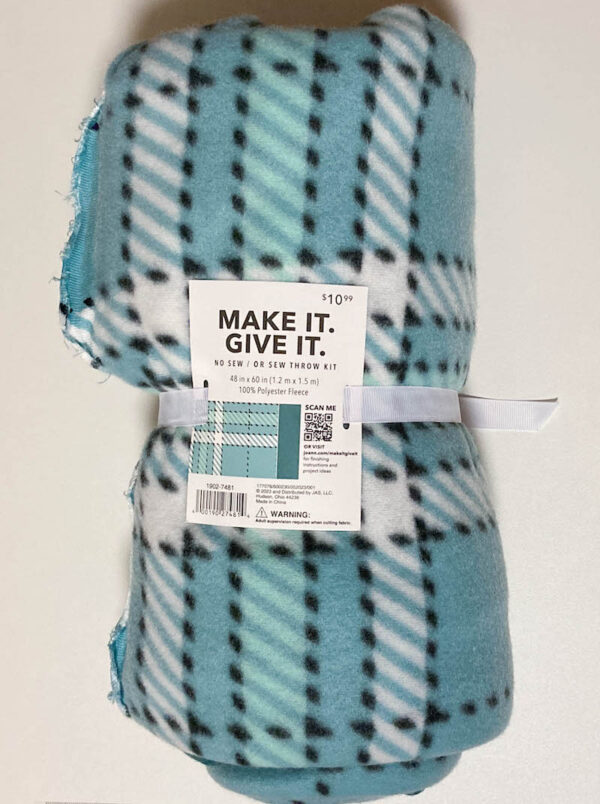
Can you iron fleece?
Because fleece is a polyester fabric, you should NOT iron or press it, as it can melt onto your iron. Polyesters are wrinkle resistant, so you can usually use a finger presser for seams. If you need to iron your project for some reason, use a heat-resistant pressing sheet on top of the fleece/between the fleece and the iron. You can also steam fleece instead of ironing.

How to find the right (front) side of fleece fabric
If you’re new to working with fleece, you may find it challenging to work with at first. It’s important to distinguish the right and wrong sides of fleece before you start cutting and sewing. If you’re making project with multiple pieces, like a garment or a toy, you’ll also want to find the direction of the nap. On some fleece fabrics, the right side is really obvious because the pile is so much more raised, but often (especially with print fabrics) it can be hard to figure out. To find the right side of your fleece fabric, locate the selvedge (the edge strip of the fabric). Stretch the selvedge and the fabric will roll towards the right side. The nap of the fleece fabric will be parallel to the selvedge.


How to cut fleece fabric
If you are sewing garments or other projects with multiple pieces, you’ll want to cut your fleece with the nap going in the same direction and the pieces facing the same side (all right side up or all wrong side up). Also, because the selvedge on fleece is woven tighter than the rest of the fabric, you’ll want to cut it off before you start sewing.
Fleece can stretch in all directions, so you may find it helpful to pin or use fabric weights before cutting to keep the fabric from shifting. If you’re cutting just one or two layers, you can use fabric sheers or a 45mm rotary cutter. However, if you’re working with more layers, you’ll want to use a 60mm rotary cutter to make smoother cuts and reduce strain on your body. Fleece tends to dull your rotary cutter, so start with a fresh blade and be sure to replace it if you’re doing a lot of cutting.

How to prepare fleece for sewing
As I mentioned before, fleece fabric stretches, so you’ll want to pin your fabric or use Wonder Clips to secure it before you begin sewing. Fabric marking pens don’t always work well on fleece. Chalk, strategic pin placement, or tailor’s tacks are the best way to mark fleece fabrics before sewing.
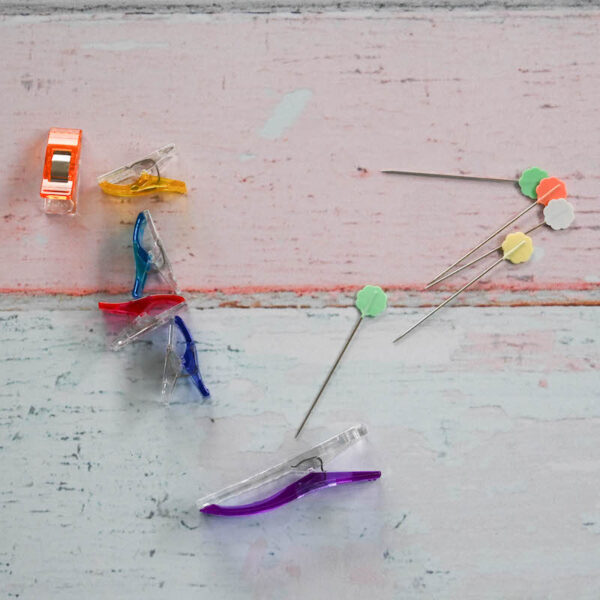
New to tailor’s tacks? The video below by my friend Hooked for Life explains what they are and how to make them.
Best needle for sewing fleece
Fleece can be tough on sewing needles, so you’ll want to start with a fresh needle on your machine and replace it more often than the standard “every 8 hours.” Instead, replace your needle after every 4-6 hours of fleece sewing.
For sewing with fleece, you can use 70/10 needles for thinner fleece, 80/12 needles for prints, and 90/14 needles for heavier fleece. You can use a stretch needle (made for sewing stretchy fabrics), a jersey or ballpoint needle (made for sewing knit fabrics), a universal needle (an all-purpose needle), or a microtex or sharp needle (made for precise stitching on polyester and other materials). If you want to do topstitching on your fleece project, I recommend the microtex needle option.

Best thread for sewing fleece
As mentioned before, fleece is a polyester (or polyester blend) fabric, and you should sew with a 100% polyester thread in your top spool and bobbin so the thread and the fabric have the same amount of “give” and you don’t break your thread during or after sewing.

Setting up your machine for sewing with fleece
When you’re ready to sew your fleece, set up your sewing machine.
- Use 100% polyester thread for both the top thread and the bobbin.
- Increase your stitch length to 3.0 or 3.5.
- While you can use a universal needle, you may find switching to a stretch, jersey, or microtex needle will be helpful. Remember to use a fresh needle and change it more frequently (every 4-6 hours) when sewing with fleece.
- You can use a standard presser foot for sewing with fleece. However, you may find that a teflon foot (which is helpful for “sticky” fabrics) or a walking foot (which helps guide thicker fabric easily through the machine) is better. I used the Baby Lock J leveling foot. This video explains how to adjust the height using the leveling button. (You can find out more about presser feet in this post: Sewing Machine Presser Foot Guide).
- Reduce your sewing speed to slow or medium.
- Sew with a 1/2″ or 5/8″ seam allowance and then trim to a 1/4″ seam allowance after sewing.
- Do not pull or push your fleece through the sewing machine as it can easily stretch. Instead, use your hand to gently guide the fabric through as you sew.
- Clean your machine regularly while sewing with fleece because it can produce a lot of lint. Be attentive to the bobbin and needle areas. Not sure how to clean your machine? This video hows how.
Use a test piece to check your thread tension and settings before starting on your main project because it is difficult to rip back once you’ve sewn on fleece.
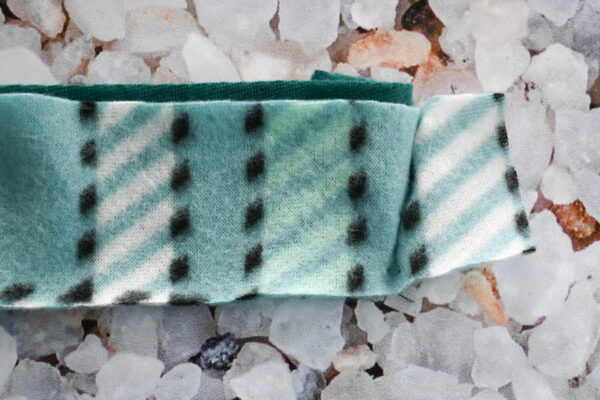
How to care for projects made with fleece fabric
Fleece can be easily spot cleaned and hand washed. You can also machine wash it in cold water on a gentle cycle. Lay flat to dry, or tumble dry low for just a few minutes and remove it promptly, rather than allowing it to go through a full cycle. Avoid using bleach, fabric softener, or dryer sheets on fleece as they can reduce the water repellency or decrease the loft.
Now that you know how to sew with fleece, read on for the pattern for the fleece blanket!
How To Sew a Fleece Blanket
Sewing Tutorial by Underground Crafter

Learn how to sew a fleece blanket with this easy peasy project that takes less time to make than a no-sew fleece blanket!
Finished Size
- Throw: Approximately 41″ (104 cm) x 57″ (145 cm).
Tools
- Sewing machine such as the Baby Lock Brilliant. Watch my Baby Lock Brilliant unboxing video below.
- If you can’t see my unboxing of the Baby Lock Brilliant above, click HERE to watch the video on YouTube.
- Cricut 45 mm rotary cutter, cutting mat, and acrylic ruler.
- If you’re new to working with a rotary cutter, the video below demonstrates how to use a rotary cutter safely.
- If you can’t see the video above demonstrating how to safely use a rotary cutter, click HERE to watch the video on YouTube.
- Wonder Clips or quilting pins.
- Basic sewing supplies (seam ripper, thread snips, etc.).
- Optional: walking foot or teflon foot.
- Optional: microtex needle.
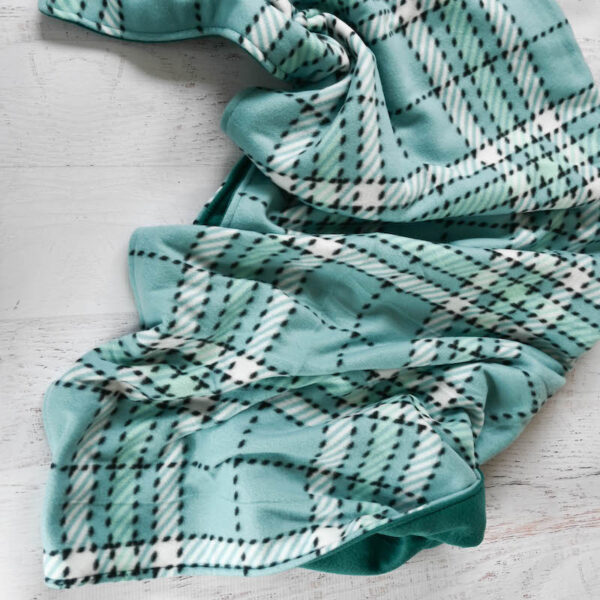
Materials
- 48″ Wide Green & Black Plaid No Sew Fleece Blanket by Make It Give It, or two cuts of 1-3/4 yard each of fleece in different fabrics.
- 100% polyester thread in your choice of color for top spool and bobbin.

Instructions
Prepare Fabric
- If you’re using yardage, start by cutting your fabric to approximately 2″ inches wider and 2″ longer than your desired length. If you’re using a Fleece Tie Blanket Kit like I did, you can just cut off the selvedge and trim any excess if one fabric piece is larger than the other.
- Position your fabric pieces with the right sides together.

- Pin or clip the fabrics together on all four sides.

- Roll the fabric so that it is easier to move through the machine.

Prepare Machine for Sewing
- Following instructions for how to sew with fleece fabric above, change your stitch length to 3.5 and reduce your speed settings to low or medium.

- Change your needle, add polyester thread to the top spool and bobbin, and change your presser foot, if necessary.
Sew Blanket
- TIP: If you’re using one striped or plaid fabric and one solid or allover print like I did, you can use the stripes or plaids to guide your stitching.
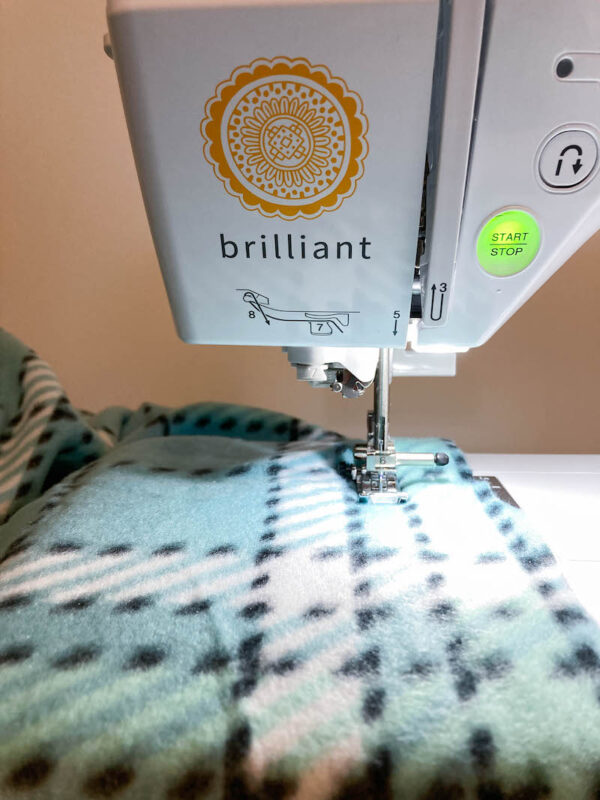
- With a 1″ seam allowance, sew through both layers with a 1″ seam on the first 3 sides, removing your pins before they reach the needle to avoid damaging your machine.
- On the fourth side, leaving an opening about 4” (10 cm) wide for turning. Finish sewing the rest of the blanket.
- Using your acrylic ruler and rotary cutter, trim any excess fabric to approximately 3/4″ outside of the seam lines.

- Clip the corners.

- Pull the fabric through the opening so that the right sides are facing out.


- Be sure to push out the corners to keep the edges squared.
- Pin the opening you left for turning the fabric right side out.

- Topstitch around the entire blanket with a 1/4″ seam allowance.
- That’s it! Wasn’t that easy?

More resources for sewing with fleece
If you’re excited about working with fleece, I’ve gathered together some helpful resources for your next project.
Online classes:
- Fun with Fleece (with Fleece Pajama Pants project) class on Craftsy
- Learn To Sew Puzzle Ball Animals with Fleece class on Annie’s
- Sewing with Fleece: Essential Techniques class on Craftsy
Reference and pattern books:
- Beginner’s Guide to Fleece with sewing and no-sew projects
- Crafting with Fleece with sewing, low-sew, and no-sew projects
- Fleece Hat Friends: 25+ Easy-to-Sew Projects
- Nancy Cornwell’s 90 Minute Fleece: 45 Projects for Beginners And Busy Sewers
- No-Sew Fleece Throws
- Sew What! Fleece: Get Comfy with 35 Head-to-Toe, Easy-to-Sew Projects
- Wild and Wonderful Fleece Animals with Full-Size Patterns for 20 Cuddly Critters
You may also want to check out free fleece sewing projects by Angel at Fleece Fun.

